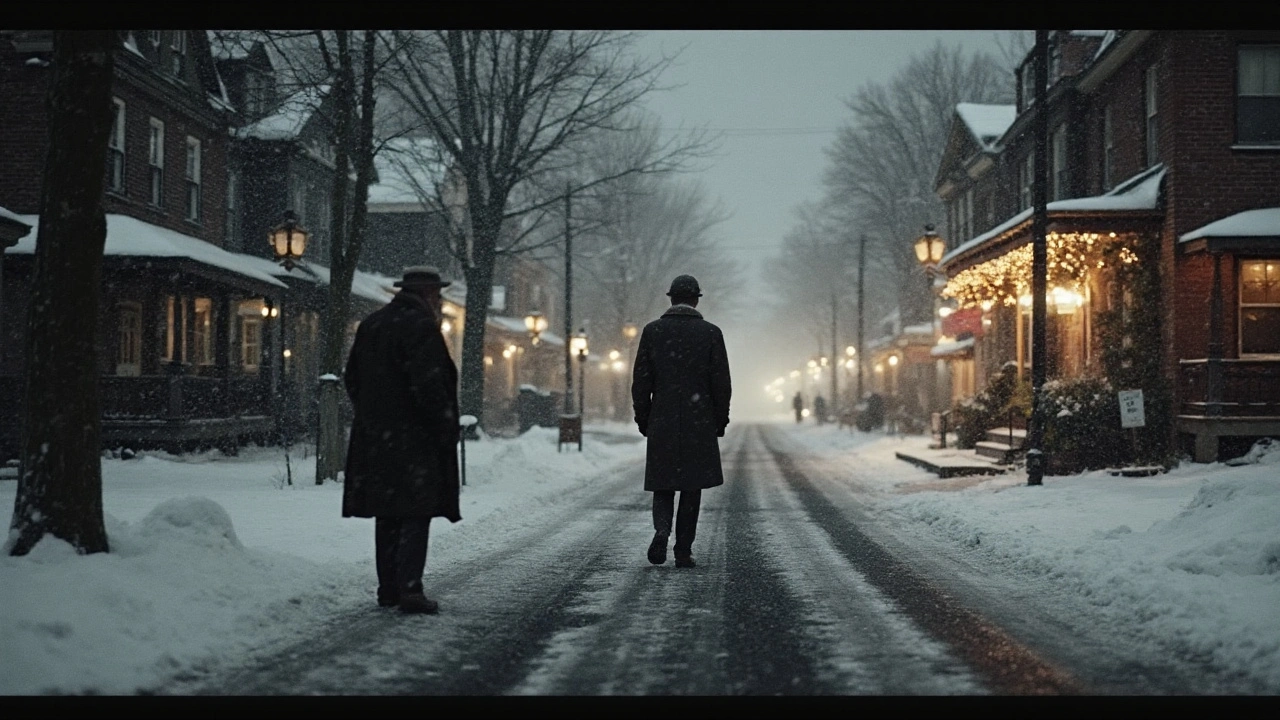You came here for a straight answer: the movie based on The Greatest Gift is It’s a Wonderful Life (1946). But the real value is knowing who wrote the story, how it turned into a film, how the film differs from the source, and where to watch it now without guesswork. I’ll make that easy, clear, and practical.
TL;DR - Quick Answer and Why It Matters
- The film based on Philip Van Doren Stern’s short story “The Greatest Gift” is It’s a Wonderful Life (1946), directed by Frank Capra and starring James Stewart and Donna Reed.
- The original story (written in 1939, privately printed as a Christmas card in 1943) follows a man who gets to see what the world would look like if he had never been born.
- Capra’s film keeps the core idea but expands it into a full life story, small-town stakes, and a community payoff.
- Don’t confuse this with unrelated titles like The Ultimate Gift (2006) or the 2018 documentary The Greatest Gift; those are different works.
- For sourcing: the AFI Catalog of Feature Films and the Library of Congress National Film Registry entries both confirm the story-to-film link.
The Story Behind “The Greatest Gift” and Its Road to the Screen
Philip Van Doren Stern wasn’t a screenwriter chasing a studio deal. He was a respected historian and editor who wrote a short story in 1939 about a man who, in a dark moment, wishes he’d never been born-and then sees that wish granted for one night. He couldn’t sell it. So in 1943, he printed roughly 200 copies of “The Greatest Gift” as a little booklet and mailed it as a Christmas card to friends and contacts. One of those copies eventually led to Hollywood.
RKO Pictures bought the screen rights in 1944. Early chatter had Cary Grant interested. RKO developed script drafts, but the project shifted when Frank Capra-fresh from his World War II service-grabbed it for his new company, Liberty Films. Capra felt the premise was personal and timely: a story about one life’s value after years of hardship and sacrifice.
Capra’s adaptation kept the “never-born” premise and the holiday setting and built a whole town around it. He, with writers like Albert Hackett and Frances Goodrich (key names you’ll spot in the screen credits), widened the story into the life of George Bailey, a small-town banker who puts family and community first while his own dreams stall. The villain, Mr. Potter, sharpened the movie’s conflict. The angel-Clarence-gave the movie its heart and its famous final beat.
It’s a Wonderful Life premiered in December 1946. It was not a smash hit out of the gate; postwar audiences had a lot to choose from, and the movie’s box office didn’t cover its budget. Then TV reruns decades later built a new audience. The film’s copyright wasn’t renewed properly in the 1970s, which pushed it into widespread public-domain broadcasts for a time; later, underlying rights (the music and the original story) and new claims gave distributors the ability to control where it aired. Once it hit the National Film Registry (Library of Congress, 1990) and grew on critics’ lists (AFI rankings), the film left the “underdog” label and settled into American holiday tradition.
If you need a single authoritative thread to pull: the AFI Catalog of Feature Films lists Stern’s story as the source, and the Library of Congress’ National Film Registry materials detail the film’s production history and cultural impact. Those two sources cover the who, when, and how, cleanly.

What’s Different? Story vs. Film - Characters, Plot, and Tone
A heads up: light spoilers ahead (the kind you’d know from a trailer). The core idea is the same-what if you were never born?-but the route and the finish differ because a 20-page short story can’t do what a two-hour movie can.
Names and roles shift. In the short story, the main character is George Pratt. In the movie, he becomes George Bailey. The story’s “guide” isn’t yet the full character of Clarence Odbody, Angel Second Class. The movie builds a vivid supporting cast: Mary, Mr. Potter, Uncle Billy, Violet Bick, and most of Bedford Falls. That town is practically a character by itself, which matters when we see its alternate reality: Pottersville.
Structure changes too. The story drops you into a desperate night and quickly spins the “never-born” vision. The film takes its time, building George’s life from boyhood to adulthood. We see choices stack up-helping his dad, saving his brother, the bank run, the missed opportunities. When the crisis hits, you feel it because the track record is clear: George has been the town’s backbone for years.
Conflict is sharper on screen. The story hints at internal conflict and the moral weight of one life. The film adds an external antagonist-Mr. Potter-whose greed and power put the whole community at risk. That amplifies the stakes of George’s absence. Without him, the town tilts toward Potter’s values: payday predation, loneliness, neon without soul.
Tone finds a new gear in the movie. The story is tender and reflective. The film swings from gentle comedy to deep despair and back to joy. There’s a reason that last-act turn lands so hard; you’ve watched George give and give until there’s nothing left-then seen how much he truly mattered. Clarence’s line “No man is a failure who has friends” isn’t in the short story, but it does capture Stern’s core idea in one sentence.
Ending notes differ. The short story ends with quieter grace; the film ends with the whole town showing up, pockets emptied, hearts full. That community surge is pure Capra-he believed in civic decency as a force you could feel. If you’re writing a paper, that’s your thesis: Stern’s premise is personal; Capra’s film turns it into a social vision about how small choices keep a community alive.
Two details film students often cite:
- Visual contrasts: Bedford Falls vs. Pottersville (lighting, signage, camera movement). Capra and cinematographer Joseph Walker make the moral difference visible.
- Sound cues and motifs: the bell ringing, the song at the end, and Dimitri Tiomkin’s uncredited musical bits-later rights around the score shaped the film’s TV life.
If you want to verify these differences quickly, watch the last 35 minutes of the film after George’s bridge scene, then read Stern’s short story. You’ll see how the same premise can blossom into wildly different textures.
How to Watch It Today + A Practical Checklist
Rights shift, holidays get crowded, and streaming menus turn over fast. Here’s how to see It’s a Wonderful Life in 2025 without wasting time.
Smart ways to find a legit copy:
- Search a streaming aggregator (JustWatch or Reelgood) for It’s a Wonderful Life to see current rental/streaming options. These sites update fast.
- Check your public library. Many carry the 4K UHD or Blu‑ray. Ask about Kanopy or Hoopla if your library offers streaming with a card.
- Look for holiday broadcasts on major networks in December. NBC has often carried it in recent years; local listings will confirm the schedule closer to the date.
- If you buy, the 4K UHD restoration is the cleanest transfer. You’ll usually get both the original black‑and‑white and a colorized version on disc.
- If a site claims “free forever,” be cautious. The film’s TV life isn’t a free‑for‑all anymore because of underlying rights. Stick to known services.
Black‑and‑white or colorized? The film was shot and lit for black‑and‑white. The colorized version is an option if your kids balk at monochrome, but if you care about the photography, choose black‑and‑white first. You’ll see why the Pottersville scenes look so stark-it’s by design.
Age guidance and content flags: This is a family film with heavy moments. Expect a suicide crisis, financial panic, drinking, and some intense arguing. Most parents are comfortable at 9-10+ with a little context. If you’re showing it to younger kids, preview the bridge sequence.
A quick checklist for first‑timers:
- Runtime: about 130 minutes. Plan a break if you’re watching with kids.
- Version: pick black‑and‑white for your first viewing.
- Sound: enable subtitles for the bank run and the crowded finale; you’ll catch more lines.
- Spot the credit: “Based on a story by Philip Van Doren Stern.” That’s your adaptation proof.
- Post‑watch chat: ask one question-Which tiny choice of George’s mattered most?
How to track down Stern’s original story:
- Search your library catalog for “The Greatest Gift Philip Van Doren Stern.” Look for the illustrated gift edition (often the 1990s Chronicle Books print).
- Ask at the reference desk for magazine reprints. The story appeared in mid‑1940s periodicals after Stern’s 1943 booklet; librarians can point you to databases with scans.
- If you buy, prefer editions that reproduce Stern’s text cleanly rather than “retellings.”
For teachers or club hosts, here’s a simple plan:
- Before: Share one paragraph from Stern’s story (the wish and the stranger). Ask students what they expect the film will add.
- During: Note when the town’s mood shifts. Count how many people George helps on his way up (and how many help him on the way down).
- After: Compare endings. Who “gives” the greatest gift-George, Clarence, or the town?
Pitfalls to avoid:
- Don’t mix up with The Ultimate Gift (2006). Similar vibe in the title, unrelated story.
- Don’t assume every free upload is legal or complete; some cuts are missing scenes or credits.
- Don’t use plot summaries for school work without cross‑checking. Watch the final act yourself; summaries often mangle Pottersville.

Mini‑FAQ and Next Steps
Is It’s a Wonderful Life in the public domain?
It’s complicated. The film’s copyright lapsed in the 1970s due to a missed renewal, which is why it aired everywhere for a while. But rights tied to the score and the underlying short story, plus new claims, re‑concentrated control in the 1990s. That’s why you now see it on specific networks and official releases. For a clean historical view, check the Library of Congress and distributor notes in the AFI Catalog.
Who owns it now?
Distribution and broadcast rights are split. In recent years, NBC has handled high‑profile holiday broadcasts, and Paramount has overseen major home‑video releases. These arrangements can change, so always check current listings or the disc publisher info.
Was Cary Grant really attached?
Yes, early development at RKO circled the project with Grant in mind. Once Frank Capra and Liberty Films took over, James Stewart became the lead and defined George Bailey for good.
Any other screen versions of the same story?
There’s a 1977 TV movie called It Happened One Christmas (a gender‑flipped riff on the film’s structure). Radio versions featuring the original stars aired in the late 1940s. Many TV episodes-from sitcoms to cartoons-have riffed on the “what if you were never born” idea. But the direct, famous adaptation of Stern’s text is the 1946 Capra film.
What’s actually in Stern’s short story?
A man named George Pratt meets a mysterious stranger on a bridge, wishes he’d never been born, and is shown a world where his absence has consequences. The tone is spare and gentle. The film builds out everything around that: family, the Building & Loan, Mr. Potter, and a crowd‑pleasing finale.
Is the colorized version “wrong” to watch?
It’s not wrong; it’s just a choice. Purists prefer black‑and‑white because the cinematography was designed for it. If color gets your household to watch, go for it. Maybe watch the black‑and‑white later to see why film folks insist it lands better.
Where do I find reliable background for a class paper?
Start with two anchors: the AFI Catalog of Feature Films entry for It’s a Wonderful Life (source, credits, release) and the Library of Congress National Film Registry essay (history and significance). For deeper dives, biographies of Frank Capra and production histories of the film fill in the details.
What common mistakes do people make when answering this question?
Two big ones: mixing up The Greatest Gift with The Ultimate Gift, and claiming the movie was always a hit. It wasn’t. The love came later, mostly thanks to TV and annual holiday viewing.
Next steps if you’re researching:
- Quote the opening premise from Stern’s story and compare it with the bridge scene in the film. Short, clean, and gets you an A on “source vs. adaptation.”
- Use the AFI Catalog for factual claims (dates, credits). Show your teacher you’re not relying on fan wikis.
- Watch the last 40 minutes twice: once as a viewer, once as a note‑taker. Track what’s missing from Pottersville without George.
Troubleshooting real‑world snags:
- Can’t find a stream in your country: Check your library’s digital partners (Kanopy/Hoopla). If not available, a region‑free disc player with the 4K/Blu‑ray solves it.
- Only colorized is available on your platform: Try another service or borrow the disc. If you must, watch the colorized now and note the lighting choices you might miss-then follow up with the black‑and‑white later.
- Need captions or descriptive audio: The major disc releases include subtitles; some platforms include audio description near the holidays. Check the platform’s “Audio & Subtitles” details before renting.
- Hosting a community screening: Don’t assume free public domain use. Contact the distributor for screening rights, especially if you’re charging admission or promoting widely.
So the answer to your original question is simple enough: It’s a Wonderful Life is the movie based on The Greatest Gift. The useful part is knowing how it got that way, how the film grew the idea into a town‑sized story, and how to watch it today without running in circles. If you keep those points straight-Stern’s Christmas card, Capra’s Liberty Films, AFI/Library of Congress for confirmation-you’ll never get tripped up by the look‑alike titles again.


